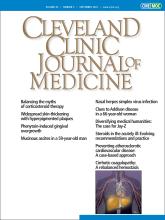A 66-year-old woman presented to our department with generalized fatigue and loss of appetite.
A review of her medical record showed that at age 52 she had undergone kidney transplant for end-stage kidney disease, receiving treatment of tacrolimus and mycophenolate after induction therapy with methyl-prednisolone 1,000 mg/day tapered over 3 months. After that, without steroids or antihypertensive drugs, her blood pressure had remained within the normal range. Mild hyperkalemia had been noted, and her fasting blood glucose was in the normal range.
On admission, her heart rate was 74 beats per minute and her blood pressure was 117/80 mm Hg. Physical examination revealed hyperpigmentation of her tongue and soft palate (Figure 1), as well as the buccal mucosa, lower lip, fingers, and nail beds. The eyelids, neck, nipples, elbows, back, knees, and soles had very mild or no pigmentation. When asked about the hyperpigmentation, the patient said that she had first noticed it more than 20 years ago but that it had not interfered with her daily life, and she had never sought medical attention for it.
Skin pigmentation in the patient’s tongue (left) and on the soft palate (right).
INITIAL WORKUP
Laboratory testing at admission showed the following:
Potassium 5.7 mmol/L (reference range 3.6–4.8)
Adrenocorticotropic hormone (ACTH) of 372 pg/mL (7.2−63.3)
Dehydroepiandrosterone sulfate 15 μg/dL (12−133)
Estimated glomerular filtration rate of 33.2 mL/ min/1.73 m2 (≥ 60)
Morning cortisol 8.93 μg/dL (6.24−18.00)
24-hour urinary free cortisol less than 12.5 μg/day (11.2−80.3)
Plasma renin activity and plasma aldosterone concentration were normal
Anti-adrenal antibody testing and cytomegalovirus antigenemia test were negative
Rapid ACTH stimulation test showed no significant increase in serum cortisol.
Computed tomography of the abdomen showed no adrenal hyperplasia, nodules, or malignant lesions.
These findings and the results of laboratory testing supported the diagnosis of Addison disease. The patient received glucocorticoid-replacement therapy without mineralocorticoid, which relieved the hyponatremia, hyperkalemia, and general symptoms. One month after the start of replacement therapy, the hyperpigmentation had improved slightly.
CAUSES AND SYMPTOMS OF PRIMARY ADRENAL INSUFFICIENCY
Addison disease, or primary adrenal insufficiency, is an uncommon disease caused by destruction of the adrenal cortex, usually owing to an autoimmune process. Other causes include infections, malignant infiltration, metabolic dysfunction, and granuloma-tous disease, as well as genetic, neonatal, vascular, pharmacologic, neoplastic, and surgical factors.1
Common clinical manifestations are fatigue, weight loss, orthostatic hypotension, skin and mucosal hyperpigmentation, nausea, vomiting, abdominal pain, libido reduction, depression, and salt-craving, depending on any deficiencies of glucocorticoids, mineralocorticoids, or androgens.1,2
Most manifestations are nonspecific and slowly progressive, so the diagnosis of Addison disease is often difficult or delayed. However, hyperpigmentation, caused by excess binding of ACTH and alpha-melanocyte stimulating hormone to the melanocortin 1 receptor,3 is a characteristic feature and a diagnostic clue for Addison disease.2
Diffuse hyperpigmentation is also caused by medications (eg, chemotherapeutic agents, antimalarials, oral contraceptives, prostaglandin agonists, amiodarone, minocycline) and by endocrine and metabolic diseases (hyperthyroidism, diabetes mellitus, hemochromatosis).4 This patient was taking none of these agents, and there was no endocrine or metabolic disease present to produce hyperpigmentation other than Addison disease.
FEATURES OF HYPERPIGMENTATION OFFER DIAGNOSTIC CLUES
The characteristics of skin hyperpigmentation can offer clues to the cause. For example, aminoquinoline drugs can induce gray-blue pigmentation on pretibial surfaces, oral mucosa, sclera, and subungual areas. Minocycline induces 3 patterns: generalized brown discoloration, dark blue discoloration confined to acne scars or areas of skin inflammation, and gray-blue discoloration on the front of the lower extremities or in exposed areas. In Addison disease, hyperpigmentation is muddy and diffuse on buccal, conjunctival, and genital mucosa and on nail beds, palmar creases, and nipples.4
TAKE-HOME MESSAGE
When Addison disease is considered in the differential diagnosis, it is important to review the patient’s medical history, to examine the skin and mucous membranes for hyperpigmentation, to measure early-morning plasma ACTH and serum cortisol, and to perform the ACTH stimulation test. Glucocorticoid and mineralocorticoid replacement therapy is essential.
DISCLOSURES
The authors report no relevant financial relationships which, in the context of their contributions, could be perceived as a potential conflict of interest.
- Copyright © 2022 The Cleveland Clinic Foundation. All Rights Reserved.







